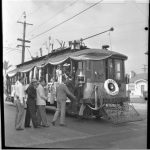Los Angeles Railway: Convenience was the name of the game
By Ralph Cantos
This is a rare photo showing an unidentified H-Class “S” car, southbound on Western Avenue at 2nd Street.
In its heyday, Los Angeles Railway cars lines “carpeted” the inner-city. Busy commercial boulevards and avenues such as Pico, Washington, Jefferson, Olympic, Whittier, East 1st and East 4th, Brooklyn Avenue, Eagle Rock Boulevard, Hill Street, Broadway, Spring, Main, Temple Street, Hawthorne Boulevard — the list was almost endless.
But LARY cars also ventured into narrow residential streets as well. Many of these streets and boulevards were served by more than one car or bus line. For the most part, the average Angeleno need only walk a block or two to catch a car or bus.
Transit service along Western Avenue from West 3rd Street to Santa Monica Boulevard was provided by both bus and rail service.
When the LARY was purchased by the Los Angeles Transit Lines, the word “CONVENIENCE” was not on the agenda of LATL. management. Almost immediately, LATL management began to trim the “convenience fat” . LATL management was more interested in paying dividends to inverters (GM, Standard Oil, Firestone Rubber, and Mack Truck) than providing LA transit riders anything approaching convenience.
“The public be damned” became LATL’s silent agenda. Shuttle rail service took an early hit, followed by duplicating rail and bus service. The bus service was give preferential treatment over rail. Rail transit service took brutal hits, system-wide. Since Western Avenue already had bus service, the “S” car was a perfect example.
The S Line on Western Avenue did not last long under LATL; that service was abandoned early on. If anyone wanted to travel northbound on Western Avenue, a transfer would now be required from former “S” car patrons. LATL management for the most part, said “the hell with convenience.” Certainly there were exceptions. No one could, or ever did, complain about the “P” car line. But system-wide, the words “transit convenience” would fade away, slowly, but surely.
If anyone ever thought that LATL management didn’t give a damn, they were in for a rude awaking when the LAMTA was created in 1958. The new LAMTA made the former LATL transit service look like paradise.
Ralph Cantos Collection






THOUGH NOTHING CAN BRING BACK THE Greatness of the RED and YELLOW CARS … We can see what is left behind and RUNNING .. at the Southern California RAILWAY MUSEUM – Orange Empire Railway Museum … PERRIS CALIFORNIA .. WE HAD IT ALL …………..
There’s one place in the world where the grid-iron pattern downtown is full of streetcar tracks, and the trams go to many points in the city. Then there are the Electric Suburban lines that go even further out (rather like the Pacific Electric did). And the people speak English. The only catch is that going there requires a 15 hour plane ride–to Melbourne Australia.
Was the top photo taken as part of an accident investigation? Looks like it was set up to emphasize the passenger safety zone with the woman on the right prepared to cross into the street. Also seems to be something at the low end of the waiting area—perhaps posed. The shadow at the bottom of the photo is interesting as it may relate to the photographer’s platform. [That checkerboard gas station sure stands out.]
The car dealership in the right was Waters Dodge Chrysler Plymouth in my day where I bought my fist car in 1975. I wanted a pick up truck they were selling but my parents insisted I buy a car instead. Turned out I got a 1968 Chevy Malibu, white with a black vinyl top. The Nash building was torn down and a Ralph’s grocery store tools it’s place in the mid 1960’s. It has since become a Korean church. The empty lot at the NW corner eventually housed the Cretto’s Bakery. I went to school with John Cretto. Lots of changes over the years. A shame about the S Line. The government controlled LAMTA was indeed responsible for driving the final nail in the coffin that killed electric transportation for decades to come.
Any idea of the date on this picture?